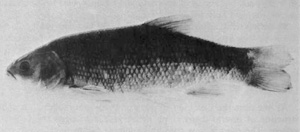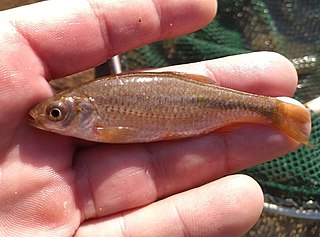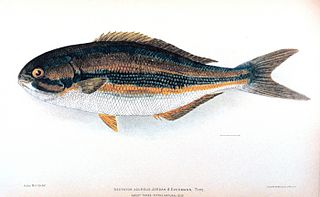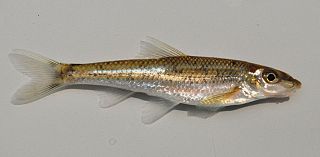A dace is a small fish that can be one of many different species. The unmodified name is usually a reference to the common dace. This, like most fishes called "daces", belongs to the family Cyprinidae, mostly in subfamily Leuciscinae.

Leuciscus is a genus of fish belonging to the family Cyprinidae. They are inland water fishes commonly called Eurasian daces. The genus is widespread from Europe to Siberia. Species broadly distributed in Europe include the common dace Leuciscus leuciscus and the ide L. idus.

The thicktail chub was a type of minnow that inhabited the lowlands and weedy backwaters of the Sacramento and San Joaquin Rivers in the Central Valley of California. It was once abundant in lowland lakes, marshes, ponds, slow-moving stretches of river, and, during years of heavy run-off, the surface waters of San Francisco Bay. The thicktail chub was one of the most common fish in California. Within Native American middens it represented 40% of the fish.

The bonytail chub or bonytail is a cyprinid freshwater fish native to the Colorado River basin of Arizona, California, Colorado, Nevada, New Mexico, Utah and Wyoming in the southwestern United States; it has been extirpated from the part of the basin in Mexico. It was once abundant and widespread in the basin, its numbers and range have declined to the point where it has been listed as endangered since 1980 (ESA) and 1986 (IUCN), a fate shared by the other large Colorado basin endemic fish species like the Colorado pikeminnow, humpback chub, and razorback sucker. It is now the rarest of the endemic big-river fishes of the Colorado River. There are 20 species in the genus Gila, seven of which are found in Arizona.
The Sonora chub is a species of ray-finned fish in the family Cyprinidae. It is found in Mexico and the United States.

The Gila chub is a species of ray-finned fish in the family Cyprinidae. It is found in Mexico and the United States. The Gila chub is closely related to the roundtail chub. This species is commonly found in association with the Gila topminnow, the desert and Sonora sucker, and the longfin and speckled dace.

The Yaqui chub is a species of freshwater fish in the family Cyprinidae. It is found in northern Mexico and the United States. The Yaqui chub is a medium-sized minnow fish that historically occurred in streams of Rios Matape, Sonora, and the Yaqui systems of Sonora, Mexico. It is one of the five species of the genus Gila in Arizona. The Yaqui chub is closely related to G. ditaenia, and G. orcutti ; and shares several physical characteristics with the G. orcutti, but proves different by having a black wedge near the base of the caudal fin.

The least chub is a species of ray-finned fish in the family Cyprinidae, the only member of the genus Iotichthys.
The sturgeon chub is a species of ray-finned minnow fish in the family Cyprinidae. It is found only in the United States. It is a species of concern in the Charles M. Russell National Wildlife Refuge in Montana.

The Oregon chub is a species of ray-finned fish in the family Cyprinidae. It is endemic to Oregon in the United States. From 1993 to 2014 it was a federally listed threatened species.

The Dnieper chub or the Black Sea chub is a species of cyprinid fish from Eastern Europe. It is found in Bulgaria, Georgia, Greece, Moldova, Romania, Russia, Turkey, and Ukraine. It lives up to eight years.
Petroleuciscus is a genus of four species of ray-finned fish in the family Cyprinidae. It was usually included in Leuciscus until recently. This genus unites the Ponto-Caspian chubs and daces. Recent research has indicated that Petroleuciscus esfahani is probably a synonym of Alburnus doriae.
The Sandhills chub is a species of freshwater fish in the family Cyprinidae of order Cypriniformes. There are 4 species of Semotilus, 2 of which occur in South Carolina. This fish is found only in North Carolina and South Carolina. The Sandhills chub is predominately found in the Carolina Sandhills and some areas of Cape Fear, Pee Dee and Santee river drainages. It is characterized by its robust body, large head and lack of a dark blotch or smudge on their dorsal fin which is present on the closely related Creek Chub. The Sandhills chub has fine scales, a pinkish body and can be up to 9.4 inches.

Chub is a common fish name. It pertains to any one of a number of ray-finned fish in several families and genera. In the UK, the term chub usually refers to the species Squalius cephalus. In addition, see sea chub.
The redtail chub is a freshwater fish found in the U.S. states of Tennessee and Kentucky.
The river chub is a minnow in the family Cyprinidae. It is one of the most common fishes in North American streams.

The gravel chub, also known as the spotted chub, is a freshwater minnow from the family Cyprinidae. This species of fish has a spotted distribution inhabiting various small rivers and streams in North America. The gravel chub requires a highly specific clean habitat making it vulnerable to various types of pollutants and in need of conservation efforts.

The flame chub is a species of freshwater fish in the family Cyprinidae found only in the United States. Its range broadly follows the Tennessee River from above Knoxville, Tennessee, to the mouth of the Duck River. Historically the species was found in Kentucky, Tennessee, Alabama and Georgia. The preferred habitat of flame chub is in small flowing streams often associated with springs.
Spotfin chub is a ray-finned fish in the family Cyprinidae that is endemic to the Tennessee River watershed. Its other common names include turquoise shiner and chromium shiner.
The Tigris chub is a species of cyprinid fish endemic to the upper Tigris drainage in southeastern Turkey.











